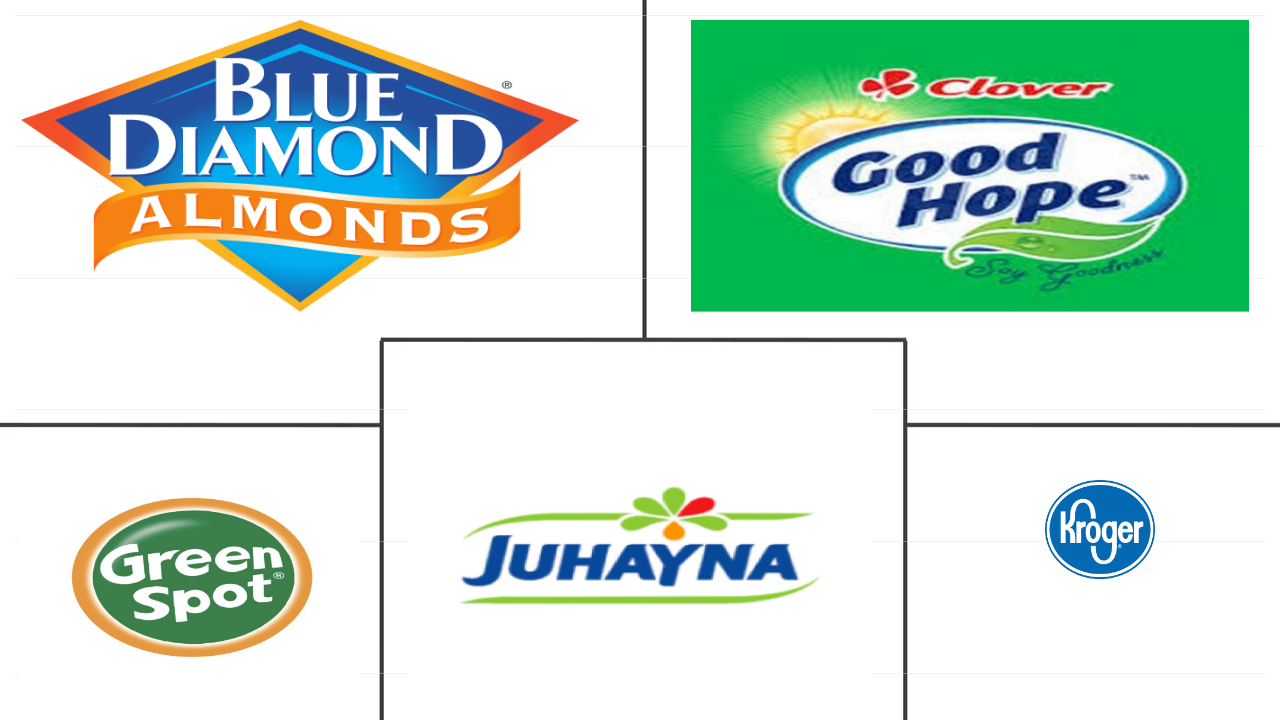Market Size of africa dairy alternatives Industry
|
|
Study Period | 2017 - 2029 |
|
|
Market Size (2024) | USD 457.4 Million |
|
|
Market Size (2029) | USD 641 Million |
|
|
Largest Share by Distribution Channel | Off-Trade |
|
|
CAGR (2024 - 2029) | 6.98 % |
|
|
Largest Share by Country | South Africa |
Major Players |
||

|
||
|
*Disclaimer: Major Players sorted in no particular order |
Africa Dairy Alternatives Market Analysis
The Africa Dairy Alternatives Market size is estimated at 457.4 million USD in 2024, and is expected to reach 641 million USD by 2029, growing at a CAGR of 6.98% during the forecast period (2024-2029).
457.4 Million
Market Size in 2024 (USD)
641 Million
Market Size in 2029 (USD)
6.23 %
CAGR (2017-2023)
6.98 %
CAGR (2024-2029)
Largest Market by Category
75.69 %
value share, Non-Dairy Butter, 2023
A steady increase in consumer awareness levels about the consumption of non-dairy foods, and the impact of animal husbandry on the environment are the key factors driving the segment.
Largest Market by Country
48.31 %
value share, South Africa, 2023
Rising cases of lactose intolerance, increasing health consciousness among consumers, and changing lifestyles are expected to bolster the growth of the dairy alternatives in South Africa.
Fastest-growing Market by Category
30.87 %
Projected CAGR, Non-Dairy Yogurt, 2024-2029
The health benefits of non dairy yogurt, such as helping to lose weight, promoting metobolism, and reducing inflammation are some of the factors contributing to segmental growth.
Fastest-growing Market by Country
7.09 %
Projected CAGR, Nigeria, 2024-2029
The rising health consciousness with needed improvement in protein and nutrient content in the diet has emerged to be the major fcator driving the country in the market.
Leading Market Player
2.36 %
market share, Blue Diamond Growers, 2022

The immense research and development activities by the player in the market which is letting it to innovate various products in the segment making it leading player.
Supermarkets and hypermarkets witness a soaring sales growth fueled by enhanced diversity in dairy alternatives aisle
- Supermarkets and hypermarkets are the region's leading off-trade distribution channels for dairy alternatives in Africa. In 2022, volume sales of dairy alternatives across the supermarkets and hypermarkets sub-segment accounted for 50% of sales through off-trade channels. Sales through supermarkets and hypermarkets are anticipated to expand at a value of 23% during the period 2024-2027 to reach a market value of USD 272.28 million in 2027. Consumer preference for these channels is driven by seasonal offers, discounts on bulk purchases, and access to diversified products through a dedicated section of dairy alternative products.
- Convenience stores are the second most widely preferred off-trade distribution channels after supermarkets and hypermarkets to purchase dairy alternatives. The sub-segment accounted for a 36% share of the overall volume sales conducted through off-trade channels in 2022. The broader reach and easy access to private-label brands drive consumer preferences for traditional grocery stores over other retail channels. The sales value of dairy alternatives through convenience stores is anticipated to grow by 22% from 2024 to 2027.
- The sales of dairy alternatives through online channels are projected to record the highest growth in value, amounting to 49.5%, during 2023-2026. The increasing number of internet users influences the evolving role of online channels in dairy alternative product purchases. Internet use in Africa increased by 23% from 2019 to 2021. As of December 2021, the internet penetration rate in Africa was 43%. The increasing number of grocery delivery apps across key countries such as Egypt and South Africa is also anticipated to drive sales through online channels during the forecast period.
Rising inclination towards Veganuary options driven by South Africa's and Egypt consumers is fueling the market growth
- Egypt and South Africa were the major regional markets for dairy alternatives, collectively accounting for a 66% share of volume sales across Africa in 2022. The growing consumer inclination toward plant-based food and the consumption of dairy alternatives, such as plant-based milk and cheese, to meet the protein and essential nutrients needs are the key factors expected to accelerate the growth of the dairy alternatives industry across the region.
- In South Africa, dairy alternative sales are estimated to expand by a value of 23% during the period 2024-2027, reaching USD 273.6 million in 2027. The growth can be attributed to the increasing veganism in the country. South Africa is among the top 30 countries worldwide in terms of its vegan population. Over 30,000 South Africans have signed up for Veganuary since 2019. Plant-based milk, such as soy and almond milk, is highly preferred in South Africa. The per capita consumption of soy milk in South Africa is expected to reach 0.07 kg in 2023.
- Sales of dairy alternatives in the rest of Africa's regional segment are estimated to grow by a value of 22% during the period 2023-2026. Countries such as Algeria, Kenya, and Ghana are contributing to the growth of the regional segment. Most countries, including Ghana, Malawi, and Zambia, are expected to have over 98-100% of their population suffering from lactose intolerance by 2023. There have also been initiatives to support vegan food, which are fueling market growth. For instance, people in Uganda often contract infections from producing and consuming animal products. To avoid or reduce the consumption of animal-based products and increase the consumption of plant-based foods, Atlas Vegan Community started the first vegan school to protect children from zoonotic disease.
Africa Dairy Alternatives Industry Segmentation
Non-Dairy Butter, Non-Dairy Milk, Non-Dairy Yogurt are covered as segments by Category. Off-Trade, On-Trade are covered as segments by Distribution Channel. Egypt, Nigeria, South Africa are covered as segments by Country.
- Supermarkets and hypermarkets are the region's leading off-trade distribution channels for dairy alternatives in Africa. In 2022, volume sales of dairy alternatives across the supermarkets and hypermarkets sub-segment accounted for 50% of sales through off-trade channels. Sales through supermarkets and hypermarkets are anticipated to expand at a value of 23% during the period 2024-2027 to reach a market value of USD 272.28 million in 2027. Consumer preference for these channels is driven by seasonal offers, discounts on bulk purchases, and access to diversified products through a dedicated section of dairy alternative products.
- Convenience stores are the second most widely preferred off-trade distribution channels after supermarkets and hypermarkets to purchase dairy alternatives. The sub-segment accounted for a 36% share of the overall volume sales conducted through off-trade channels in 2022. The broader reach and easy access to private-label brands drive consumer preferences for traditional grocery stores over other retail channels. The sales value of dairy alternatives through convenience stores is anticipated to grow by 22% from 2024 to 2027.
- The sales of dairy alternatives through online channels are projected to record the highest growth in value, amounting to 49.5%, during 2023-2026. The increasing number of internet users influences the evolving role of online channels in dairy alternative product purchases. Internet use in Africa increased by 23% from 2019 to 2021. As of December 2021, the internet penetration rate in Africa was 43%. The increasing number of grocery delivery apps across key countries such as Egypt and South Africa is also anticipated to drive sales through online channels during the forecast period.
| Category | ||||||||
| Non-Dairy Butter | ||||||||
| ||||||||
| Non-Dairy Yogurt |
| Distribution Channel | |||||||
| |||||||
| On-Trade |
| Country | |
| Egypt | |
| Nigeria | |
| South Africa | |
| Rest of Africa |
Africa Dairy Alternatives Market Size Summary
The Africa Dairy Alternatives Market is experiencing significant growth, driven by increasing consumer preference for plant-based products and the rising prevalence of lactose intolerance across the continent. Supermarkets and hypermarkets dominate the off-trade distribution channels, offering consumers seasonal discounts and a wide range of dairy alternative products. Convenience stores also play a crucial role, benefiting from the accessibility of private-label brands. However, online channels are projected to witness the highest growth, fueled by the increasing number of internet users and the proliferation of grocery delivery apps in key markets like Egypt and South Africa. The market is characterized by a diverse range of products, including plant-based milk and cheese, which are gaining popularity due to their nutritional benefits and alignment with vegan lifestyles.
Egypt and South Africa are the leading markets within the region, collectively accounting for a significant share of volume sales. The growth in these markets is attributed to the rising vegan population and the growing demand for plant-based foods to meet nutritional needs. In South Africa, the expansion of dairy alternative sales is particularly notable, with a strong preference for soy and almond milk. The market is fragmented, with major players like Blue Diamond Growers and Juhayna Food Industries leading the charge. Recent developments, such as acquisitions and new product launches, indicate a dynamic market landscape, with companies continuously innovating to cater to the evolving consumer preferences for dairy alternatives.
Africa Dairy Alternatives Market Size - Table of Contents
-
1. MARKET SEGMENTATION (includes market size in Value in USD and Volume, Forecasts up to 2029 and analysis of growth prospects)
-
1.1 Category
-
1.1.1 Non-Dairy Butter
-
1.1.2 Non-Dairy Milk
-
1.1.2.1 By Product Type
-
1.1.2.1.1 Almond Milk
-
1.1.2.1.2 Coconut Milk
-
1.1.2.1.3 Oat Milk
-
1.1.2.1.4 Soy Milk
-
-
-
1.1.3 Non-Dairy Yogurt
-
-
1.2 Distribution Channel
-
1.2.1 Off-Trade
-
1.2.1.1 Convenience Stores
-
1.2.1.2 Online Retail
-
1.2.1.3 Specialist Retailers
-
1.2.1.4 Supermarkets and Hypermarkets
-
1.2.1.5 Others (Warehouse clubs, gas stations, etc.)
-
-
1.2.2 On-Trade
-
-
1.3 Country
-
1.3.1 Egypt
-
1.3.2 Nigeria
-
1.3.3 South Africa
-
1.3.4 Rest of Africa
-
-
Africa Dairy Alternatives Market Size FAQs
How big is the Africa Dairy Alternatives Market?
The Africa Dairy Alternatives Market size is expected to reach USD 457.37 million in 2024 and grow at a CAGR of 6.98% to reach USD 641.01 million by 2029.
What is the current Africa Dairy Alternatives Market size?
In 2024, the Africa Dairy Alternatives Market size is expected to reach USD 457.37 million.

